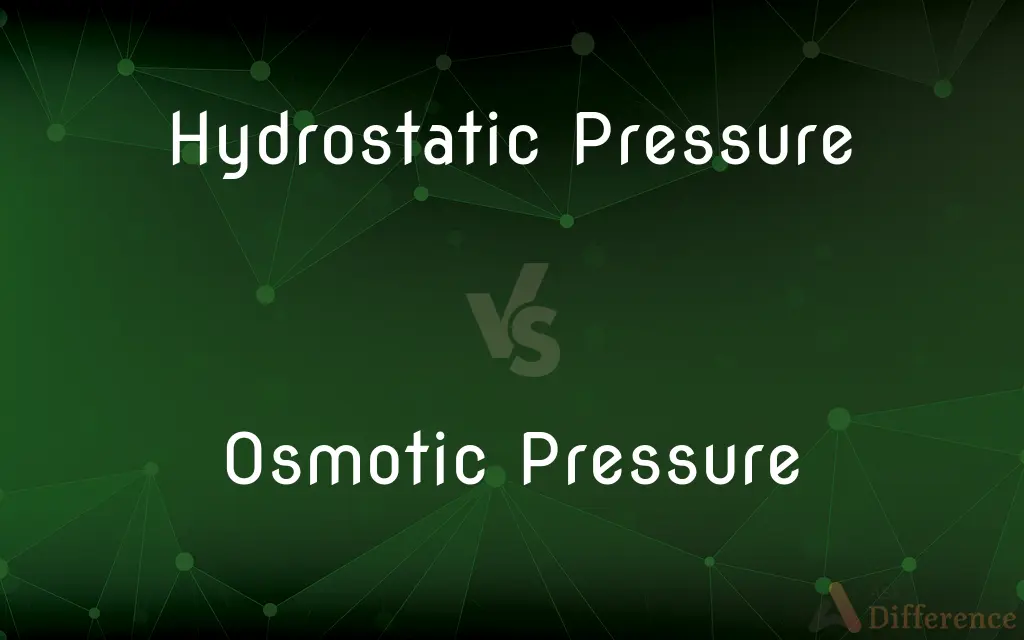Hydrostatic Pressure vs. Osmotic Pressure — What's the Difference?
By Tayyaba Rehman — Published on December 29, 2023
Hydrostatic Pressure is exerted by the weight of a fluid, while Osmotic Pressure arises from the solute concentration difference across a semipermeable membrane.

Difference Between Hydrostatic Pressure and Osmotic Pressure
Table of Contents
ADVERTISEMENT
Key Differences
Hydrostatic Pressure relates to the force exerted by a fluid due to its weight, acting at any given point within the fluid. This pressure increases with depth. In contrast, Osmotic Pressure is the pressure required to prevent the flow of solvent molecules through a semipermeable membrane due to differences in solute concentrations.
In biological systems, Hydrostatic Pressure can be observed in blood vessels. For instance, the blood pressure within our arteries is a form of hydrostatic pressure. Meanwhile, Osmotic Pressure plays a critical role in processes like osmoregulation in cells, where the balance of water and solutes is maintained.
Hydrostatic Pressure is largely dependent on gravity and can be easily demonstrated by the pressure increase in deeper parts of a pool or an ocean. Conversely, Osmotic Pressure is independent of gravity and is directly related to the tendency of solute molecules to draw water molecules towards regions of higher solute concentration.
In medical contexts, Hydrostatic Pressure in the blood vessels pushes fluid out into the tissues, while the Osmotic Pressure, due to plasma proteins, draws fluid back into the vessels. An imbalance between these pressures can lead to conditions like edema, where excess fluid accumulates in the body tissues.
Comparison Chart
Origin
Exerted by the weight of a fluid.
Arises from solute concentration differences across a semipermeable membrane.
ADVERTISEMENT
Examples in Biology
Blood pressure in arteries.
Osmoregulation in cells.
Dependence
Depends on fluid's depth and density.
Depends on solute concentration.
Role in Body
Pushes fluid out of blood vessels.
Draws fluid into blood vessels due to solute concentration.
Relation to Gravity
Directly influenced by gravity.
Not influenced by gravity.
Compare with Definitions
Hydrostatic Pressure
Pressure in a fluid at rest resulting from its depth and density.
Hydrostatic Pressure increases as you descend in a column of water.
Osmotic Pressure
Pressure exerted due to solutes in a solution when separated by a permeable membrane.
Osmotic Pressure can impact plant cell turgidity and rigidity.
Hydrostatic Pressure
The pressure exerted by a fluid at rest due to its weight.
The deeper you dive in the ocean, the greater the Hydrostatic Pressure on your body.
Osmotic Pressure
Pressure needed to prevent solvent flow across a semipermeable membrane.
Osmotic Pressure determines the flow of water in and out of cells.
Hydrostatic Pressure
The force per unit area exerted by a fluid against a surface.
Dams are built to withstand the Hydrostatic Pressure of the stored water.
Osmotic Pressure
The potential pressure difference between two solutions separated by a membrane.
In medical treatments like dialysis, Osmotic Pressure is crucial for fluid and waste balance.
Hydrostatic Pressure
The force applied by a stationary fluid on an object.
Hydrostatic Pressure can cause ruptures in underwater pipelines if not managed.
Osmotic Pressure
Force from a solute's tendency to draw water towards areas of higher concentration.
Consuming very salty food can raise the body's Osmotic Pressure, leading to thirst.
Hydrostatic Pressure
A pressure acting on a surface submerged in a still fluid.
Hydrostatic Pressure tests are performed to check the strength of containers.
Osmotic Pressure
The force from the difference in solute concentration on either side of a membrane.
High salt concentration outside a cell can increase the Osmotic Pressure, causing the cell to shrink.
Common Curiosities
What happens when Osmotic Pressure is too high in cells?
High Osmotic Pressure can cause cells to lose water and shrink.
How is Osmotic Pressure generated?
Osmotic Pressure is generated due to differences in solute concentration across a semipermeable membrane.
Why is Osmotic Pressure important in biology?
Osmotic Pressure maintains water and solute balance in cells, ensuring their proper function.
How does gravity affect Hydrostatic Pressure?
Gravity directly influences Hydrostatic Pressure by pulling the fluid downwards, increasing its weight.
Does temperature affect Osmotic Pressure?
Temperature can influence the solubility and concentration of solutes, thus affecting Osmotic Pressure.
Can Hydrostatic Pressure damage structures?
Yes, excessive Hydrostatic Pressure can damage structures like dams or pipelines.
How does Hydrostatic Pressure change with depth?
Hydrostatic Pressure increases with depth due to the increasing weight of the fluid.
Can Hydrostatic Pressure be felt in the air?
Yes, atmospheric pressure is a form of Hydrostatic Pressure due to the weight of the air above us.
What causes Hydrostatic Pressure?
Hydrostatic Pressure is caused by the weight of a fluid.
What's the relation between Hydrostatic Pressure and fluid flow?
Hydrostatic Pressure can drive fluid flow, especially in enclosed systems or vessels.
How do organisms regulate Osmotic Pressure?
Organisms use osmoregulation mechanisms, like selectively transporting solutes, to regulate Osmotic Pressure.
Can Osmotic Pressure be manipulated in medical treatments?
Yes, treatments like dialysis manipulate Osmotic Pressure to regulate fluid and waste.
Why is Osmotic Pressure vital for plants?
It maintains cell turgidity, which is essential for plant rigidity and structure.
How is Hydrostatic Pressure measured?
It is often measured using piezometers or manometers.
Are Hydrostatic Pressure and Osmotic Pressure always opposing forces in the body?
Typically, yes. In blood vessels, Hydrostatic Pressure pushes fluid out, while Osmotic Pressure pulls it in.
Share Your Discovery

Previous Comparison
Annual General Meeting vs. Extraordinary General Meeting
Next Comparison
Cheap vs. SteepAuthor Spotlight
Written by
Tayyaba RehmanTayyaba Rehman is a distinguished writer, currently serving as a primary contributor to askdifference.com. As a researcher in semantics and etymology, Tayyaba's passion for the complexity of languages and their distinctions has found a perfect home on the platform. Tayyaba delves into the intricacies of language, distinguishing between commonly confused words and phrases, thereby providing clarity for readers worldwide.












































